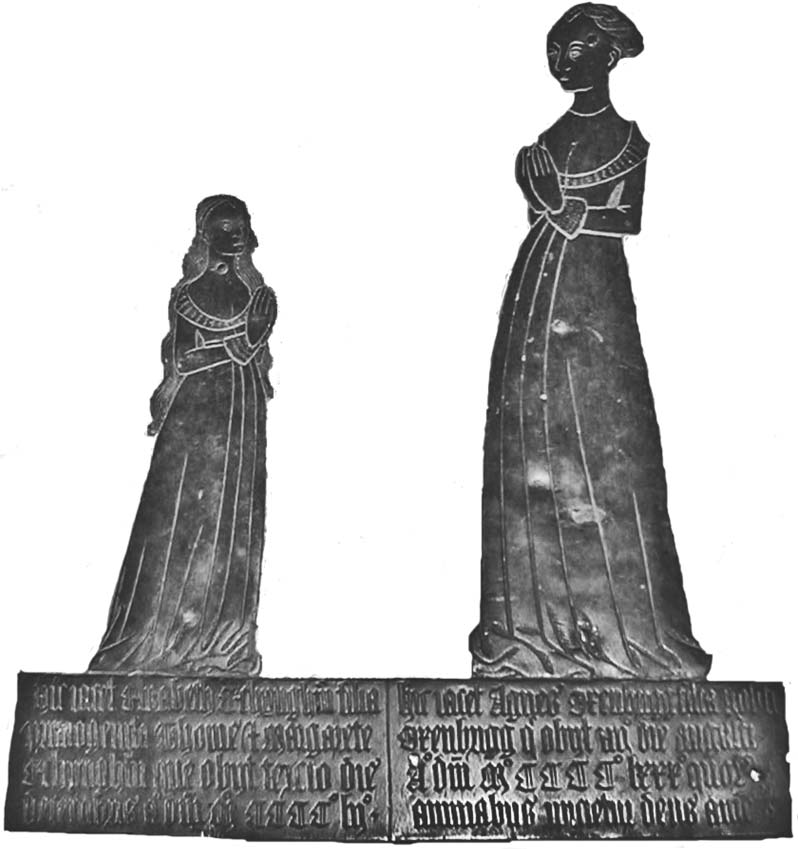Kim Racon
How many medieval lesbians do you know? Or, are you wondering if there even were any lesbians in the Middle Ages? To paraphrase a line from Diane Watt’s recent Bright Club appearance, some women in the Middle Ages knew they were lesbians—they just didn’t know they were medieval!

The memory of two never-married women, Elizabeth Etchingham (d. 1452) and Agnes Oxenbridge (d. 1480), examined by the historian Judith Bennett, offers an intriguing potential example. The women are commemorated jointly in perpetuity through a monumental brass laid in the church at Etchingham, East Sussex. Both are depicted, with equal force, turned towards each other in semi-profile, a design shift that only began by 1480. The workshop charged with creating the brass broke from its pattern of distanced poses when creating this particular example. The iconography suggests two women who shared an affectionate relationship: their gowns are arranged in such a way as to suggest movement towards each other. They look directly at each other. The simple brass perhaps tells a complex story of intimacy between the women.
How do we recover the lives of women whose stories are perhaps even more hidden and more coded than other medieval women’s lives and stories already are? Where and how can we look for evidence of female same-sex experiences and intimacy? After all, women wrote less, and the writings they did produce survive less often than that of their male counterparts. Women were also generally less likely than men to come to the attention of civic or religious authorities. What then of the even more obscured lesbian experiences of some women? Contemporary accounts by medieval theologians, canonists, and physicians were relatively untroubled by this particular sexual deviance: physicians discussed male homosexuality more fully, while authors of penitentials either ignored lesbianism or considered it a lesser sin than male homosexuality. Theologians similarly trivialized it, perhaps because while this was same-sex love, it was love among the lesser sex in medieval society.
Modern scholarship also presents obstacles for working out medieval lesbianism. Typically, critical examination offers a heteronormative view of history and historical people, where references to queer practices may be interpreted out of existence as a result of homophobic anxiety. Studies that promote examination of the lesbian premodern, like the edited collection by Noreen Giffney, Michelle Sauer, and Diane Watt, are relatively few in number. Moreover, scholars of the premodern, in this case anyone before the nineteenth century, are often confronted with the vocabulary argument. “Lesbian” smacks of contemporaneity for both traditional medievalists and queer theorists, in spite of the fact that the term itself has considerable antiquity. The Byzantine commentator Arethas associated “lesbian” with same-sex relations between women—so, to at least one person in the tenth-century, “lesbian” roughly signified then what it roughly signifies today.
But is it always just about sex? I think any lesbian (especially one who has experienced so-called lesbian bed-death) will most likely tell you “no” — sexual behavior is important, but need not be the defining characteristic of an identity or intimate relationship. Judith Bennett argues for the use of the term “lesbian-like” to help broaden our perspective on relationships between women in the Middle Ages. For Bennett, ‘lesbian-like’ includes “women whose lives might have particularly offered opportunities for same-sex love; women who resisted norms of feminine behavior based on heterosexual marriage; women who lived in circumstances that allowed them to nurture and support other women.” The term is distinct from the argument Adrienne Rich puts forth in her essay “Compulsory Heterosexuality and Lesbian Experience.” Rich labels all woman-indentified experience on a “lesbian continuum” of “primary intensity between and among women” involving both “sharing of a rich inner life” and “bonding against male tyranny.” Bennett’s term focuses on identity but also practices, creating possibilities to both name “lesbian” and decenter it by highlighting likeness and resemblance, but it is not predicated on the bonding that is at the focus of Rich’s argument. This dual purpose is, I think, integral to reading the past, as well as the past informing the present.
Broadening the scope of what ‘counts’ as lesbian also forces us to speculate that lesbian history could actually look quite different from what our assumptions suggest or current values promote. ‘Lesbian-like’ forces us to reconsider relationships between single women, like that between Elizabeth Etchingham and Agnes Oxenbridge. We will likely never be certain as to what their relationship actually was. Yet, the decision to commemorate the intense relationship these two women shared in their twenties was a deliberate one when Agnes died nearly thirty years after Elizabeth, as their joint funerary brass illustrates. The social history that ‘lesbian-like’ encompasses can also include the ex-prostitutes of Montpellier and women in religious communities, as well as cross-dressing women like the young, anonymous woman from Krakow. ‘Lesbian-like’ can playfully disrupt the heteronormative assumptions we bring to female mystical texts and experiences, like that of Margery Kempe or Hildegard of Bingen. Medieval elites may have been indifferent or at times even openly hostile to ‘lesbians’, but medieval society may nonetheless have actually been filled with possibilities for lesbian expression.
 Kim Racon is a PhD candidate and adjunct lecturer in the Department of English at Lehigh University. Her dissertation, The goodwyfe had meche to doo: Wives & Work in Late Medieval English Literature, examines the difficulties in articulating and making visible the work of rising merchant class wives. Kim also writes the This Buzz for You column at The Buzz About and tweets from: @raconteursaurus
Kim Racon is a PhD candidate and adjunct lecturer in the Department of English at Lehigh University. Her dissertation, The goodwyfe had meche to doo: Wives & Work in Late Medieval English Literature, examines the difficulties in articulating and making visible the work of rising merchant class wives. Kim also writes the This Buzz for You column at The Buzz About and tweets from: @raconteursaurus

NOTCHES: (re)marks on the history of sexuality is licensed under a Creative Commons Attribution-NonCommercial-NoDerivatives 4.0 International License.
Based on a work at www.notchesblog.com.
For permission to publish any NOTCHES post in whole or in part please contact the editors at NotchesBlog@gmail.com





May I point out the logical flaw in first saying that lessbian is an ancient term that broadly means the same as today, and then proceeding to adopt a much wider definition, however interesting the results of that wider definition might be.
The ancient understanding, morover, is surely based upon the imagined private lives of observed women seen in the light of emotional relationships characterised by the reputation passed down of Sappho, and, to lesser extent the fragments they had at the time of her works, which were once widely distributed. Sex probably was not an essential part of that. Nor, in all likelihood was rejecting patriarchy.